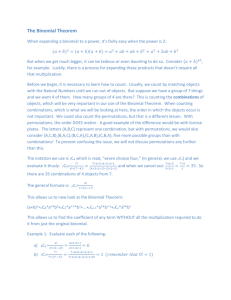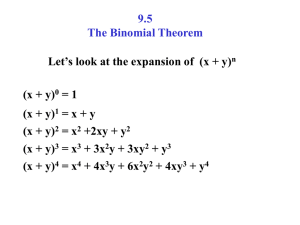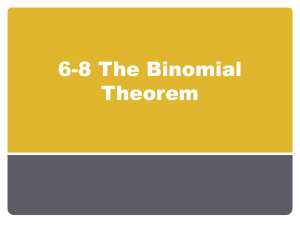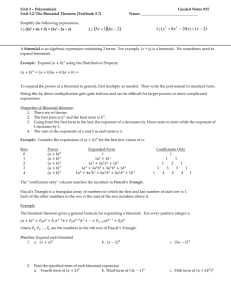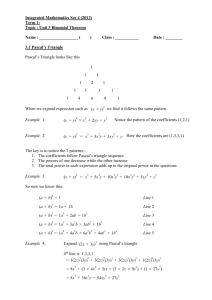Unimodal Rays in the Ordinary and Generalized Pascal Triangles
advertisement
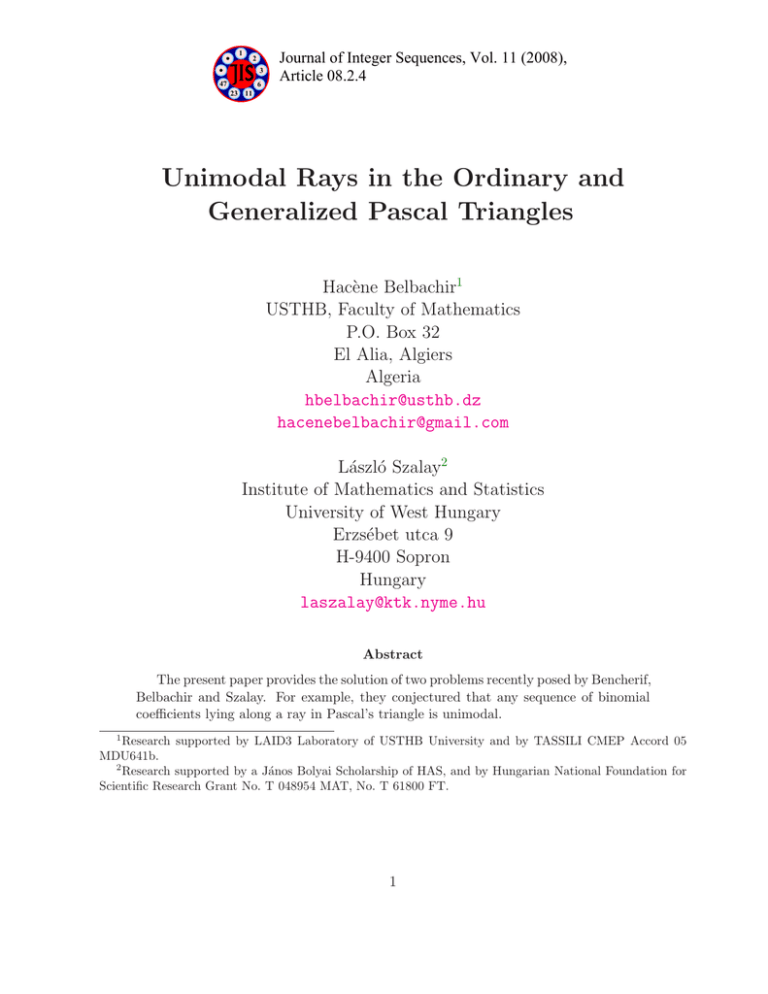
1
2
3
47
6
Journal of Integer Sequences, Vol. 11 (2008),
Article 08.2.4
23 11
Unimodal Rays in the Ordinary and
Generalized Pascal Triangles
Hacène Belbachir1
USTHB, Faculty of Mathematics
P.O. Box 32
El Alia, Algiers
Algeria
hbelbachir@usthb.dz
hacenebelbachir@gmail.com
László Szalay2
Institute of Mathematics and Statistics
University of West Hungary
Erzsébet utca 9
H-9400 Sopron
Hungary
laszalay@ktk.nyme.hu
Abstract
The present paper provides the solution of two problems recently posed by Bencherif,
Belbachir and Szalay. For example, they conjectured that any sequence of binomial
coefficients lying along a ray in Pascal’s triangle is unimodal.
1
Research supported by LAID3 Laboratory of USTHB University and by TASSILI CMEP Accord 05
MDU641b.
2
Research supported by a János Bolyai Scholarship of HAS, and by Hungarian National Foundation for
Scientific Research Grant No. T 048954 MAT, No. T 61800 FT.
1
1
Introduction
Let ω denote a positive integer or infinity. A real sequence {ak }ωk=0 is unimodal if there
exists a non-negative integer λ such that the subsequence {ak }λk=0 increases, while {ak }ωk=λ
decreases.
If λ = 0 then the sequence is monotone decreasing. Therefore it is also natural to consider
a monotone increasing sequence as unimodal with λ = ω, even if ω = ∞.
If a0 ≤ a1 ≤ · · · ≤ am−1 < am = · · · = aM > aM +1 ≥ aM +2 ≥ · · · then the integers
m, . . . , M are called the modes of the sequence. In case of m = M , we talk about a peak;
otherwise the set of modes is called a plateau.
A non-negative real sequence {ak } is logarithmically concave (log-concave or LC for short)
if
a2k ≥ ak−1 ak+1
for all k ≥ 1.
Unimodal and log-concave sequences occur in several branches of mathematics (see, for
example [5, 6]).
Our main interest is to examine combinatorial sequences connected to Pascal’s triangle
and its generalizations. The first result dealing with unimodality of the elements of the
Pascal
to Tanny and Zuker [7], who showed that the sequence of the terms
triangle is due
n−k
n
(k = 0, . . . , 2 ) is unimodal. In fact, the LC property of the sequence formed by the
k
was proved, and this implies unimodality by Theorem 1. They
binomial coefficients n−k
k
in [8, 9].
also investigated the unimodality of n−αk
k
n n−k
connected to Lucas
Benoumhani [4] justified the unimodality of the sequence n−k
k
numbers. Recently, Belbachir and Bencherif [1] proved that the elements 2n−2k n−k
and
k
n−k
n−2k n
2
linked to the Pell sequence and its companion sequence, respectively, provide
k
n−k
unimodal sequences. In all the aforesaid cases the authors descibe the peaks and the plateaus
with two elements. Incidentally, the paper [2] generalizes certain results on unimodality of
sequences mentioned above.
One of the purposes of this work is to prove that any ray crossing Pascal’s triangle hits
elements of an unimodal sequence (Theorem 4 and Corollary 5). Further, we will show
that unimodality appears when we consider the generalized Pascal triangle linked to the
homogeneous linear recurrence {Tn } of order s given by the recurrence relation
Tn = Tn−1 + · · · + Tn−s ,
n≥s
(1)
and by the initial values
T0 = · · · = Ts−2 = 0, Ts−1 = 1
(2)
(Theorem 7 and Corollary 8). Questions of a similar kind were posed in the paper of
Belbachir, Bencherif and Szalay [2].
For the proofs we will need the following two theorems.
Theorem 1. A log-concave sequence {ak } with no internal zeros is also unimodal.
See, for instance, [5].
2
Theorem 2. The ordinary convolution of two log-concave sequences preserves the LC property. More precisely, if both {an } and {bn } are log-concave, then so is {cn } with
cn =
n
X
(n = 0, 1, . . . ).
ai bn−i
i=0
See, for instance, [10].
2
Rays in Pascal’s triangle
Let u ≥ 0 and v denote integers, and as usual let
u!
, if 0 ≤ v ≤ u;
u
v!(u−v)!
=
0,
otherwise.
v
(3)
The main advantage of such an interpretation P
of binomial
coefficients is, P
for example,
that
one can omit the use of exact limits in sums like ui=0 ui by simply writing i ui instead. In
the sequel, for the sake of convenience, we exploit this kind of allowance. As a demonstration,
we state Vandermonde’s identity here, without proof.
Lemma 3. For arbitrary integers u ≥ 0, k ≥ 0 and v we have
X u
k
u+k
.
=
v−i
i
v
i
For the set of non-zero binomial coefficients we use the phrase Pascal’s triangle. Since any
row R(u) (u ≥ 0) of the Pascal triangle is the convolution powers of the log-concave constant
sequences {1} and {1}, it follows that R(u) is a log-concave sequence by Theorem 2, even if
we extend R(u) by (3). (The log-concavity of a row in the Pascal triangle also follows from
the direct application of the definition of LC property.)
Now we are ready to prove
Theorem 4. The sequence of binomial coefficients located along a ray is log-concave.
By Theorem 1, we immediately obtain
Corollary 5. The sequence of binomial coefficients located along a ray is unimodal.
Proof of Theorem 4. Since the sequence of zeros is trivially log-concave, it is sufficient to
prove the case when
the ray passes through at least one binomial coefficient in the Pascal
triangle. Let uv00 denote such a coefficient. Thus 0 ≤ v0 ≤ u0 , and with the integers α and
β satisfying α2 + β 2 > 0 let us consider the sequence {xk } given by
u0 + αk
xk =
,
(4)
v0 + βk
3
where the integer k varies over all cases when u0 + αk ≥ v0 + βk ≥ 0. Since the choice
k = 0 is feasible, the sequence {xk } contains at least one positive element.n Without
loss
o
u0
is the
of generality we may suppose that gcd(α, β) = 1. If α = 0 then {xk } =
v0 ±k
log-concave row R(u0 ) of binomial coefficients.
provide logSimilarly, if β = 0 then one can readily show that the terms xk = u0v±k
0
concave sequence. To deduce this statement, it suffices to show by recalling the definition of
log-concavity, that
2
u0
u0 + 1 u0 − 1
,
if 0 ≤ v0 ≤ u0 − 1,
(5)
≤
v0
v0
v0
since the direction of a ray is reversible. By simply extracting the binomial coefficients, we
can check that the above inequality is equivalent to u0 − v0 ≤ u0 .
Moreover, there isno restriction in assuming that α and β are positive because of the
n
of Pascal’s triangle (or generally, by (3), the symmetry of binomial
symmetry nk = n−k
coefficients).
element of {xk } for which 0 ≤ u = u0 +αk
Suppose now, that uv (where 0 ≤ v ≤nu) is the
o
u+αk
contains {xk } as a subsequence.
is minimum. Then the sequence {x̄k } = v+βk
k≥0
By Lemma 3, it is clear that
X u + (α − 1)k
k
u + αk
.
=
x̄k =
v + βk − i
i
v + βk
i
(6)
are from the row R(k) and R(u+(α−1)k) of
Since the terms ai = ki , and bi = u+(α−1)k
v+βk−i
binomial coefficients, respectively, they clearly form log-concave sequences. Thus {x̄k } is
also log-concave. Indeed, k ≥ 0, and by u ≥ 0 and α ≥ 1 we have u + (α − 1)k ≥ 0, so
the two sequences framing the convolution really exist. Then the proof of Theorem 4 is
complete. ⋄
3
Generalized Pascal triangle and sequences Tn
The elements nk s of the generalized Pascal triangle have the following combinatorial in
terpretation. The term nk s assigns the number of different ways of distributing k uniform
objects among n boxes,
where each box may contain at most
s objects. Clearly,
0 ≤ k ≤ sn.
Pn−1
n
In other words, k s = f : {0, . . . , n − 1} → {0, . . . , s} | i=0 f (i) = k .
For instance, if s = 2 we obtain the triangle
1
1 1 1
1 2 3 2 1
1 3 6 7 6 3
..
.
4
1 ,
n−1
u
n−1
+
,
supposing
non-negative
u
in
having the value
+
where nk 2 = n−1
k 2
v 2
k−1 2
k−2 2
zero if v < 0 or 2u < v. Note that we omit the subscript 1 and write only nk for the
usual binomial coefficients if s = 1. Now we formulate a lemma on generalized binomial
coefficients, which will be useful in the proof of Theorem 7.
Lemma 6. If s ≥ 2 then we have
min{k,n} X
k1
n
n
.
=
k
−
k
k
k s
1
1
s−1
k1 =⌈ ks ⌉
(7)
Proof of Lemma 6. Clearly, if we want to distribute k elements, first we choose k1 boxes
by putting one object into each of them, and then we distribute the remaining k−k1 elements
among the k1 boxes that have been chosen, with at most s − 1 elements per box. ⋄
Notice that we can ignore the
indication of limits in the sum (7) by recalling that for
non-negative u the coefficent uv s = 0 if the integer v is out of the range 0, . . . , su.
The generalized Pascal triangle nk s , n ∈ N; 0 ≤ k ≤ sn is linked to the linear recurrence
{Tn } given by (1) and (2) via the diagonal sum
sn
⌊X
s+1 ⌋ n−k
k=0
k
= Tn+s .
(8)
s
(For reference, see, for instance [3].) The case s = 1 returns the nice identity
n
⌊X
2⌋
n−k
k=0
k
= Fn+1
for Fibonacci numbers A000045, while s = 2 is connected to the Tribonacci numbers
A000073. In
the sequel, to extend Theorem 4, we investigate not only the diagonal elen−k
ments k s , but any sequence of elements locating along a ray. Hence, in the generalized
Pascal triangle, we consider
the log-concavity of a more general sequence {wk } given by
u+αk
wk (s; u, v; α, β) = v+βk . We will prove that the sequence {wk } is log-concave, and conses
quently unimodal. We have
is log-concave if s ≥ 2.
Theorem 7. The sequence containing the terms wk = u+αk
v+βk s
n
o
Corollary 8. The sequence {wk } = u+αk
is unimodal for any positive integer s.
v+βk
s
Proof of Corollary 8. It comes immediately from Corollary 5 and Theorem 7. ⋄
For the proof of Theorem 7 we need the following
Lemma 9. Given positive integers n and s, the sequence {yk } =
5
n
o
k
n−k s
is log-concave.
Proof of Lemma 9. In case of s = 1 the possible values for k are
lnm lnm
,
+ 1, . . . , n.
(9)
2
2
Put t = n − k, which goes through on the range n2 , n2 − 1, . . . , 0 when k takes its
values
from
the range (9). From the reversibility of the order, the sequence of the terms
k
n−t
= t is log-concave by [7] (or see Introduction of the present paper).
n−k
Assume now that Lemma 9 holds for s − 1 ≥ 1 with all non-negative integer n. We have
X k k
m
yk =
=
.
(10)
n−k s
m n − k − m s−1
m
k is log-concave. By the assertion
As remarked above, the Pascal triangle row R(k) = m
m
n
o
m
of the induction, n−k−m s−1
is also log-concave. Applying Theorem 2, we conclude that
m
k
the terms yk = n−k s form a log-concave sequence. ⋄
Now we turn our attention to the
Proof of Theorem 7.
If s ≥ 2, by Lemma 6 we have
X u + αk m
u + αk
.
wk =
=
v
+
βk
−
m
v + βk s
m
s−1
m
As we have already noted, the row R(u+αk) =
u+αk
m
(11)
of the Pascal triangle is logn
o
m
is provided
concave. On the other hand, the log-concavity of the sequence v+βk−m
m
s−1
m
by Lemma 9. Now it follows from Theorem 2 that the ordinary convolution (11) is also
log-concave. The proof of Theorem 7 is complete. ⋄
4
Acknowledgments
This work was prepared during the visit by the first author to the University of West Hungary;
he wishes to express his thanks for the support and kind hospitality of the Institution of
Mathematics and Statistics. The second author would like to thank F. Luca for his valuable
remarks.
References
[1] H. Belbachir and F. Bencherif, Unimodality of sequences associated to Pell numbers, to
appear, Ars Combinatoria.
[2] H. Belbachir, F. Bencherif and L. Szalay,
Unimodality of certain sequences connected to binomial coefficients, J. Integer Seq. 10
(2007), Article 07.2.3.
6
[3] H. Belbachir, S. Bouroubi and A. Khelladi, Connection between ordinary multinomials, generalized Fibonacci numbers, partial Bell partition polynomials and convolution
powers of discrete uniform distribution, http://arxiv.org/abs/0708.2195.
[4] M. Benoumhani, A sequence of binomial coefficients related to Lucas and Fibonacci numbers,
J. Integer Seq. 6 (2003), Article 03.2.1.
[5] F. Brenti, Unimodal, log-concave, and Pólya frequency sequences in combinatorics,
Mem. Amer. Math. Soc. 81 (1989), no. 413.
[6] R. P. Stanley, Log-concave and unimodal sequences in algebra, combinatorics, and geometry, Ann. New York Acad. Sci. 576 (1989), 500–534.
[7] S. Tanny and M. Zuker, On a unimodality sequence of binomial coefficients, Discrete
Math. 9 (1974), 79–89.
[8] S. Tanny and M. Zuker, On a unimodal sequence of binomial coefficients, J. Combin. Inform. System Sci. 1 (1976), 81–91.
[9] S. Tanny and M. Zuker, Analytic methods applied to a sequence of binomial coefficients,
Discrete Math. 24 (1978), 299–310.
[10] Y. Wang and Y. N. Yeh, Log-concavity and LC-positivity, J. Combin. Theory, Ser. A
114 (2007), 195–210.
2000 Mathematics Subject Classification: Primary 11B65; Secondary 05A10, 11B39 .
Keywords: unimodality, log-concavity, generalized binomial coefficients, generalized Fibonacci numbers.
(Concerned with sequences A000045 and A000073.)
Received May 6 2008; revised version received June 9 2008. Published in Journal of Integer
Sequences, June 20 2008.
Return to Journal of Integer Sequences home page.
7

